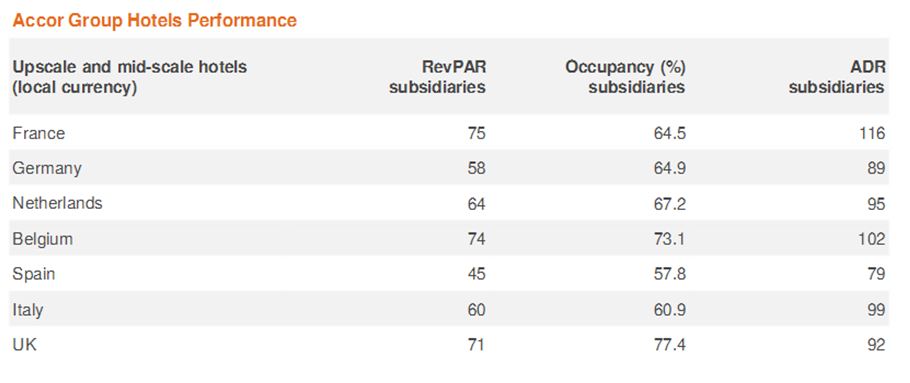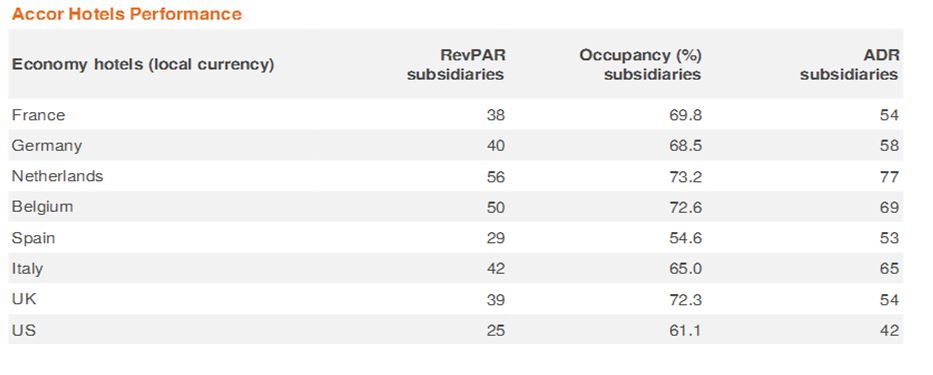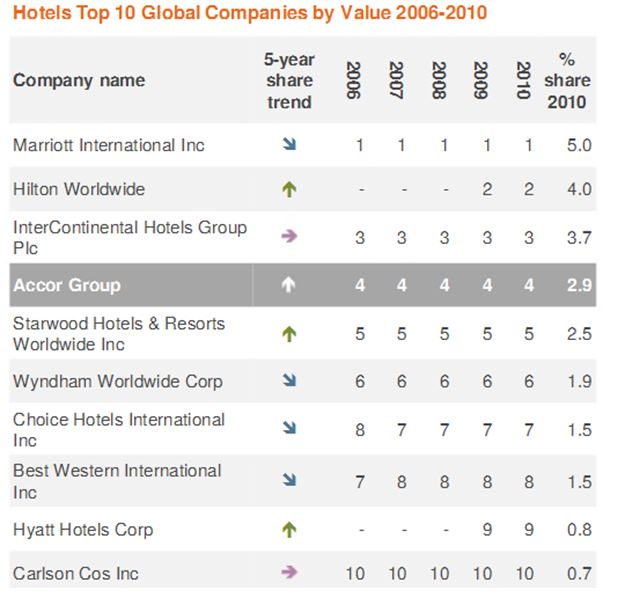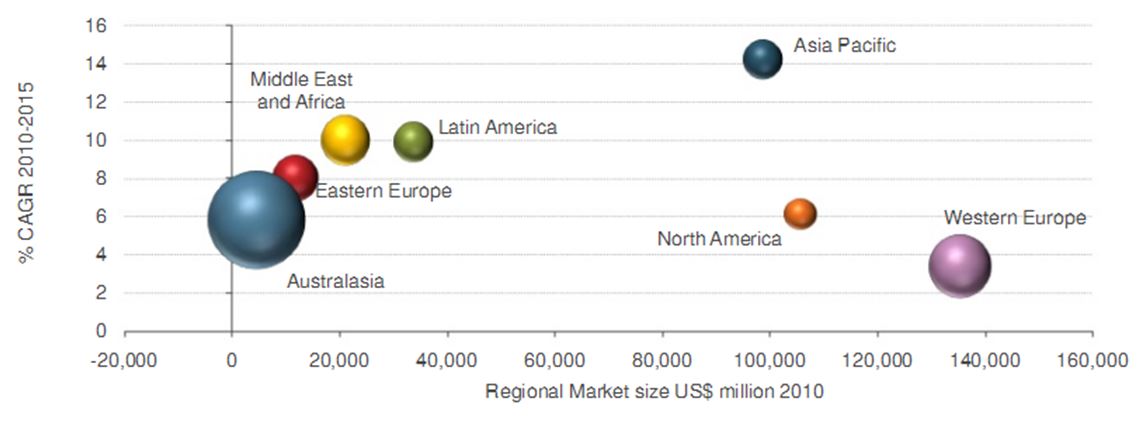Executive Summary
Accor is a market leader in the hotel, hospitality, and tourism industries, in Europe and internationally. The company’s operations are spread across more than 100 countries, and the company employs a labor force of 150,000 employees. The company has 15 complementary brands, including Sofitel and MGallery among others. The strategic programs and processes of the company that have worked effectively include its efforts to become the market leader in Europe. The company has also employed the strategy of investing in emerging markets, which has worked well in different markets including the Asia Pacific and the Middle East. The financial strategy of the company has been effectively deployed. The strategy entailed the asset-light approach, shifting investment towards budget and mid-scale service provision and targeting high potential markets. The company has employed a strategy of cultivating its major areas of strengths, including its wide brand portfolio, the pipeline development model, and its relatively high market presence. The global market positioning of the company was another effective strategy. This led to an increase in the company’s presence in different markets. Accor has employed a strategy of selective investing in emerging markets, placing focus on high potential markets in the Middle East and the Asia Pacific. The strategy has worked effectively for the company, indicating the need for further expansion. These markets include India, China, and Indonesia. Accor has also benefited from the strategy of investing in environmentally-friendly operation models at its hotels, which has worked during a pilot testing program in 10 hotels. The program is expected to increase market presence.
Introduction and Company Background
Accor is a leading hotel company in Europe and is claimed to be the third-largest hotel services company. For over forty years, the company has reinvented its major areas of competency, towards keeping pace with the competition (Ramboll management, 2002). The company’s established brands, emphasize the development of interpersonal relations and unique ways of service delivery to their customers. The company operates in about 100 countries and employs a labor force of 150,000 (Accor, 2010a). The company operates about 15 complementary brands, ranging from budget to luxury centers, which are famed for their delivery of high-quality services and products, across the globe. The group offers services to business and leisure travelers (Accor, 2010a). The Groups’ major brands include Pullman, Sofitel, Novotel, MGallery, Suitehotel, Mercure, All Seasons, Ibis, Formulae 1, Etap Hotel, Motel 6, and HotelF1 (Ramboll management, 2002). As of June 2010, the Group had more than 4100 hotels across the 100 countries covered, and a room capacity of more than 500,000 rooms.
Accor is one of the best hotels in the world. It has establishments in different parts of the world. The Accor Hotel Group has established a strong brand in the world market. Essentially, the company operates in close to a hundred nations around the world. The company has many employees over 130,000 (Bouncken and Pyo, 2002).
Competition and industry analysis
Hospitality is one of the industries that are faced with critical competition. Accor faces competition from other established players in the industry. Some of the competitors include Hilton Group Plc., Marriot International, Intercontinental, and Starwood among others. Accor has moved fast to curb competition from the competitors. For instance, towards the end of the 20th century, the company went into partnerships with other companies to achieve success. The partnerships were an indication of Accor’s determination to appease the customers. In this case, the company has adopted the group to group strategy for the benefit of the clients. In essence, such a strategy is suitable for organizations that offer interrelated services or those targeting similar customers. In this case, the business network for Accor is quickly advancing.
Environmental Analysis of Accor
Five Forces Model
The analysis of the external environment of Accor using the Five Forces Model reveals interesting facts. The five forces include barriers to new entrants, rivalry, the power of suppliers, substitutes, and buyer power. The industry in which Accor operates has a low score regarding the barriers to new entrants (Bonham, 2008). The barriers include hotel operating license, capital, building a distribution network, and getting the human resources. These aspects can easily be acquired by competitors. In addition, the rivalry in the industry is very high. In this case, there are numerous competitors that Accor has to face. There are also exit barriers that work to increase rivalry in the industry. Furthermore, the power of suppliers is low. In this case, there are many suppliers, advanced technology, and switching costs. In the analysis of the substitutes, the score is very low. In this case, substitutes are readily available and offer competitive pricing. This leads to switching costs, which does not help the company. Lastly, the buyer power is quite high considering the tough economic times. In this case, the buyers are sensitive about what they spent. In addition, there are low switching costs, and buyers prefer substitutes (Henry, 2008; Bonham, 2008).
SWOT Analysis
The SWOT analysis is very important for any business organization. This entails the analysis of the organization’s strengths, weaknesses, opportunities, and threats. The strength and weaknesses are part of the internal environment of an organization (Bonham, 2008; Henry, 2008). Regarding Accor, various strengths can be identified. Essentially, it can be noted that the company has a great reputation. It can also be acknowledged that the company has a corporate culture that is appealing to clients. In addition, the company has reputable customer service. These are some of the aspects that act as strengths of the company. Accor has a high brand recall. This also acts as one of the company’s strengths. The company caters to all cadres of clients targeting both the high-end and low-end market. Accor also engages in various businesses to increase its profitability. The other strength of Accor is its immense financial strength. The company has also adopted the online strategy where clients can have their reservations through the internet. Accor’s weakness can be noted in its non-strategic business which has led to the loss of clientele. Another weakness is that the company has high fixed costs, which do not compare favorably with companies in other business categories. This may be problematic especially when there is reduced demand for the services offered.
Apart from the internal analysis, other aspects account for the external analysis. This includes the opportunities and threats (Henry, 2008; Bonham, 2008). Accor has opportunities to expand in the global market and reach into areas where there is great potential. The company is an established brand and can thus merge, acquire, or partner with other firms to maximize profits. Accor can enhance its sponsorship deals across the world that will work to enhance its business strategies. The internet presents an opportunity for Accor to advertise its services to the whole world. The company can also conduct internal promotions that incorporate aspects of the local countries of operations. Some of the threats facing Accor include stiff competition from players in the hospitality industry. In addition, given that Accor is operating in different countries. In this case, the company is faced with the threat of fluctuating currencies. This has a great impact on the profitability of the company. In essence, fluctuations in currencies have negative impacts on the company’s profits. Furthermore, another threat emanates from geopolitical instability, as well as a global economic meltdown. In this case, unfavorable political situations and terrorist threats are some of the challenges that Accor has to face.
The Strategic Planning and the Processes of the Accor Group
The company’s aspirations to become a market leader in Europe
The demerger of the company’s voucher service business in 2010 was among the strategic actions that opened the way for the company to concentrate on its hospitality sector. Through the demerger, the company shifted its attention to cash flow generation and deleveraging. The demerger was strategically planned, so it could pave the way for the company’s involvement in asset development and consolidating its corporate leadership. By the end of the year 2009, the company had 814 hotels under its ownership structure (Higgins, 2010). However, during its deleveraging phase of between 2010 and 2013, the company strategized on disposing 450 of the hotels under its control, for cash returns of $ 1.97 billion, at an attuned debt impact of $ 2.5 million. By April of 2010, the company had already realized above half of the target amount of the 2010 program, at $ 552.6 million. According to Olivier Poirot, the CEO of Accor NA, the Company anticipated that by the year 2011-2012, it will have cleared its debts. The company will still have many properties in its portfolio (Higgins, 2010).
Through the strategy, the company expected to invest approximately $ 245.6 million towards the development of between 35,000 and 40,000 new rooms-openings annually. For instance, the strategy streamlines on Ibid and Etap brands, which will form the core of expansion in Europe. In line with the strategic projections, the company anticipates having 20 percent of its holdings of fixed-leased or owned properties. The remainder will fall under management, franchising, and variable lease plans (Higgins, 2010). About 58 percent of the company’s guestrooms should fall under budget and the economy classes. The company expects to control 700,000 rooms globally; 48% of the room portfolio is in Europe, 20% in the Asia/Pacific market, and 19% of the North American territory (Higgins, 2010).
Accor’s interest in emerging markets
This strategic market positioning was started through aggressive development by investing in China, Brazil, UK, and India, throughout 2010. Accor has successfully developed characteristic brands, all of which are differentiated from one another, and a competitor’s brand. Through the strategy, the company has increased its presence internationally (Viladon, 2013). In ensuring that the strategic improvement of its market presence is realized, the company has developed a department dedicated to increasing the visibility of the company’s brands and making the brands easily noticeable. Accor does that through the strengthening of customer loyalty programs. It also enhances the knowledge of customers about their services (Viladon, 2013). The expansion into emerging markets has entailed increasing the company’s budget and mid-range accommodation, which offers the company a platform, from which to present more options for customers (Hill and Jones, 2010). The strategy is aimed to serve leisure tourists from the different markets and focal destinations, changing their market positioning from a company dominated by 5-star services, to a wider market player, serving mid-range customer groups (Viladon, 2013).
In the emerging markets, Accor is increasing its presence, focusing on high potential markets, including China, Brazil, and India. According to the strategic projections of the company, as of 2015, it anticipates enhanced coverage of its market network (Accor, 2011). The company plans to engage in selective investing, where the focus is channeled towards high-margin projects. These projects cover the prime locations of the market, particularly in the European segment of the emerging markets. The strategy of the company entails expanding business in the development of franchising deals (Accor, 2011). In pursuit of the 2015 strategic goals, the company plans to embrace external growth opportunities through entering into strategic acquisitions and partnerships. The strategic expansion modules are expected to strengthen the company’s leadership in the target markets, particularly at attractive, emerging markets (Hill and Jones, 2010). The focus of this strategy is channeling a larger part of the company’s business into the asset-light structure of the business (Accor, 2011).
Towards the pursuit of the strategy, Accor exceeded the set target for openings in 2011. It increased its room offering by 37,800 bedrooms (Accor, 2011). The company planned to acquire 40,000 bedrooms annually, for the years 2012 and 2013. The larger aspect of increasing the company’s room holding will be done through expanding their franchises and management contracts (Accor, 2011).
Table 1: Accor Group’s Brand Portfolio in 2010
Source: (Viladon, 2013)
The Financial Strategy of Accor
The financial returns for the year ended 31 December in 2010 depicted that the company was improving financially. The hotel revenues stood at EUR 5,693 million, which marked a 10 percent increase from the same financial period for the previous year (Accor, 2010a). The strategic changes that caused the 10 percent increment included the expansion of development programs, which increased the company’s revenues by EUR 75 million, the focus on mid-priced and budget customer bases, and the company’s focus on the asset-light outlook. The asset-light outlook reduced the company’s corporate debt significantly (Accor, 2010a). The mid-scale and upscale segments were among the major performers of the company, leading to financial progress in the European territory, particularly in Germany, France, and the UK. The three markets saw increases in occupancy rates, leading to an increase in the standard room rates (Accor, 2010a).
The French market was characterized by a principally strong performance, which resulted from an increase in the flow of inbound tourism, and business-related tours in the country (Accor, 2010a). Hotel sales were also expected to increase, at a level of more than 3.6 percent between the years 2010 and 2015. The financial strategy of Accor also benefited from the cost-saving model introduced in 2009, as well as the continued increase in the economy class hotels in markets outside the US, which added to the operational financial results (Accor, 2010a).
Table 2: Accor Group’s key financial Indicators for the year 2009/2010
Source: (Accor, 2010a) Revenue consolidated and restated, accounting for disposals and demerger.
The Strategic Strengths cultivated by Accor
The company presents a wide brand portfolio, operating in varied market segments. This strategy offers the company a competitive advantage. Thus, it can attract a wider customer base, and expand its product and services offering. The company uses the pipeline development model, which focuses on the available growth opportunities in the Middle East and the Asia Pacific (Accor, 2010a). This has contributed to the company’s high-profile market presence and service offering in emerging markets. Through its strategy of expanding market presence in emerging markets, the company has realized 70 recent development contracts, in the Asia Pacific in 2010 (Accor, 2010b). The new developments added to the initial hotel rooms holding by 16,000 rooms, in the company’s offering portfolio. The company has the potential to expand its growth in these markets, particularly in Asia-Pacific. This is due to its increased market presence in these emerging markets (Higgins, 2010).
The Global Market Positioning of Accor
The company maintained a strong brand portfolio, despite the deteriorating economic conditions experienced during the crisis and conditions of increasing operational costs. The strategy was realized through the market positioning of many of the company’s brands as mid-scale and budget (Accor, 2010b). Through the market conditions-guided approach, the company was able to minimize the effect of the downturn on its market performance. The high performance of the company was also fostered by the company’s brand awareness and the strong occupancy rates, especially in the European market. The increasing market demand helped maintain the performance of the company, regardless of the wavering market conditions (See Appendix 3: Accor’s Global ranking).
Regionally, the company focused on Western Europe, throughout 2010. Western Europe is the market from which it sources a larger component of its hotel services revenues. However, the company expanded into Latin America and the Asia Pacific, where it anticipates drawing major value growth. As a result, the company kept increasing its hotel coverage in these target market regions (Accor, 2013). The company took advantage of the increasing consumer spending in some of the emerging markets, particularly Latin America. The target population for this market was the emerging middle class in countries like Brazil, whose economy proved resilient to the impacts of the global recession. The company anticipates the benefits it expects to gain from the high financial flexibility of the market, as well as the improvements of commodity pricing, which left the tourism and travel industries unaffected.
Accor’s Strategic Investment Patterns Across Asia Pacific and Middle East
The company is investing its resources in emerging markets in a selective manner, based on a strategy aimed at committing resources in areas that present the best opportunity for revenue generation. The target markets in the Asia Pacific include India, China, and other Asia Pacific markets, including Padang, Kuta, and Bangka. The company plans to invest in the Middle East after it identified the region as an emerging market with a high potential for expansion (Accor, 2013).
China
Towards taking advantage of the Indian and Chinese markets, Accor entered into 25 new contracts in the mid-scale and luxury segments of the market in 2010. The company entered into these new deals through a few of its brands, including Mercure, Novotel, Sofitel, and Pullman (Accor, 2013). The new company outlets are based at the following locations: Zhuhai, Guiyang, Huizhou, and Changsha. The new deals increased the company’s presence in the country, where it had 100 hotels and about 26,500 rooms spread across 42 cities. The market portfolio of the company comprises 15 upscale, 23 luxury, 44 economy hotels, and 18 mid-scale hotels (Accor, 2013).
India
In India, the company projected investing $ 130 million, which were expected to cover 50 hotels, by the end of 2012. In India, the company is using three of its major brands, including Ibis, Novotel, and Mercure. During early 2010, the company communicated its plans to develop 90 hotels in India, between the years 2010 and 2015 (Accor, 2013). As of Dec 2010, the company had entered into contracts, for the construction of the 90 hotels. The company planned to introduce more of its established brands in the Indian market, including Pullman, Sofitel, and Formulae 1, during the financial year 2011-2012. The strategy paid off in India as the market was barely affected by the economic crisis. The impacts of the crisis were not felt by the Indian economy. In this case, the large, dynamic economy characterized by a high number of middle-class consumers presents a major opportunity for business development (Accor, 2013).
Other Asia Pacific areas
The Accor company strategized on the opening of eight new hotels in Indonesia, by the end of 2012. The locations for the new hotels include, Padang, Manado, Surabatya, Kuta, Balikpapan, Jakarta, Denpasar, and Bangka (Accor, 2013). The strategic expansion in the region was expected to increase the value share of the company, as well as to outweigh the business of the competition in the hospitality industry. The company strategized on expanding its coverage, by opening 12 other hotels in Vietnam, which will increase its room holding by 2000 rooms during the year 2013 (Accor, 2013).
Middle East
The company strategized on capturing the potential of the emerging market, by starting five Ibis hotels in the region. The company expects to reach 54 hotels, and coverage of more than 12,497 rooms by the end of 2014. As of 2011, the company had nine hotels opened in the region. During 2012, the company had strategized on expansion by opening four hotels. Among the hotels, 2 were located in Bahrain, 2 in Saudi Arabia, 2 and 3 in Syria, which were to create about 1,500 jobs (Accor, 2010b). Further expansion was to be done through franchising locally, at locations like Damman, Jeddah, and Makkah. In Saudi Arabia, the company has strategized on the opening of nine hotels, with a longer-term plan to increase the number by 15 property investments, within 5 years (Accor, 2013).
The New Category Focus On Sustainable Tourism and Development
The company has identified that in a world with an increasing demand for authentic business experiences and greener means, new expansion opportunities will be created. This will increase the sustainability of its eco-tourism and development (Accor, 2010b, p. 60-63). Among the strategic positioning programs that have worked for the company include the Green Key eco-rating project. After pilot-testing the program, the Green Key Eco-rating model will be spread across the company’s studio 6 properties and Motel 6 centers. The program on green performance inspects the resorts and hotels, certifying them based on carrying out their everyday operations in ways that depict commitment to sustainable practices (Accor, 2010ba, p. 63-65). The areas checked before the hotels are certified include levels of operational costs, mainly in the areas of water, waste levels, and energy consumption. Through the green operations platform project, the company will enhance its competitive advantage. In this case, it will earn the support and the strategic endorsement of green-operating players internationally (Accor, 2010b; Kaplan and Norton, 1996).
Conclusion
Accor is a leading hotel company in Europe and a major industry player globally. The company has been in operation for more than forty years, employing strategic processes in its major areas of competency towards meeting the challenge of competition. The company employs its strategies towards the improvement of the quality of its services, positioning its products and services, and maintaining an environment-friendly performance. The strategies that work for Accor Company include positioning itself as a market leader within the European market, which entailed the demerger with Voucher Services to focus on the provision of hospitality and tourism services. The second effective strategic model was the company’s focus on emerging markets, and focusing its deployment on the provision of mid-scale and budget services.
The financial strategy of the company has been a highly successful one as it has increased the company’s revenues. The strategy entails expanding the company’s provision of budget and mid-scale services, adopting the asset-light approach, and the expansion of development programs. The cultivation of strategic strengths has worked effectively for the company, which touched on different areas including increasing the company’s presence in the Middle East and the Asia Pacific. The global positioning of the company is another strategy that has worked effectively. It has focused on highly potent markets including the Asia Pacific and the Middle East. Accor’s strategic development has focused on investing in sustainable development and tourism, where the company is streamlining its operations to eco-friendly standards, which will improve its competitive edge in the short and the long term.
References
Accor. (2010a). Accor: 2010 Annual Report. Web.
Accor. (2010b). Investor day 2010: Paris. Accor Group, 4-35. Web.
Accor. (2011). Accor: 2010 Annual Report: New frontiers in Hospitality. Web.
Accor. (2013). Accor’s strategic vision. Web.
Bonham, S. S. (2008). Actionable strategies through integrated performance, process, project, and risk management. Boston: Artech House.
Bouncken, R.B. and Pyo, S. (2002). Knowledge management in Hospitality and Tourism. New York: Routledge.
Henry, A. (2008). Understanding strategic management. Oxford: Oxford University Press.
Higgins, S. (2010). Accor demerger paves way for a new strategy. Hotel News Now. Web.
Hill, C., and Jones, G. (2010). Strategic management: An integrated approach. Boston: Houghton-Mifflin.
Kaplan R., and Norton, D. (1996). The balanced scorecard: translating strategy into action. New York: Harvard Business School Press.
Ramboll management. (2002). Case Study: Accor Hotels, The European e-Business Watch, 1 (2), 2-3.
Viladon, D. (2013). Accor moves towards emerging markets and away from owning hotels. Web.
Appendix
Appendix 1: RevPar performance for Mid-scale and Up-scale brands

Appendix 2: RevPar performance for Economy brands

Appendix 3: Accor’s Global Ranking for years between 2006 and 2010

Appendix 4: Accor’s growth and market presence prospects by region between 2010 and 2015

The size of the bubble shows the share of the market held by Accor, during 2010.
